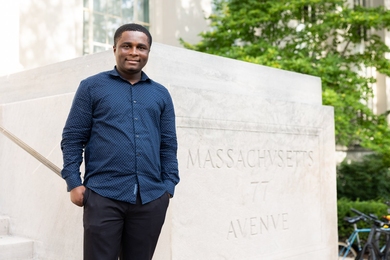Reacting to both market changes that have lowered the yield of retirement annuities and to a federal law that ends mandatory retirement, MIT has taken steps to make retirement more attractive.
Several amendments to the MIT retirement plan, approved by the Executive Committee of the MIT Corporation at its November 4 meeting, were outlined by President Charles M. Vest at the November 16 faculty meeting.
During the past several months, President Vest said, the retirement plan has "come under intense discussion." The motivations for the discussions are multifaceted, he said but the "primary triggering event" was a federal law preventing mandatory retirement ages. The retirement age for faculty members had been 70.5 years. University administrators across the nation are concerned that the the new law will pose a problem for faculty renewal-the addition of talented young men and women to tenure-track faculty positions.
In addition to the new law, President Vest said, market behavior since 1993 has driven the rate of the annuities that fund retirements much lower than they have been for a number of years, a development that has caused some MIT faculty and administrators to postpone retirement.
Dr. Vest, before briefly outlining the amendments to the retirement plan, said that the changes will be communicated in detail in the near future. Early next year, some time after January's Independent Activities Period, there will be a forum for a broad discussion of retirement issues, he said.
The changes to the plan listed by Dr. Vest were:
- An "uplift" in fixed annuity benefits. The Institute will make a temporary adjustment to bring the annuity rate to 7.25 percent and couple this with a market-value adjustment of 5 percent. "This would move the annuity rate to the general area of 8 percent," Dr. Vest said. The change applies to fixed annuity payments starting between January 1, 1995, and January 1, 1996, and to fixed annuities originally purchased on or after January 1, 1993, which are eligible for the market value adjustment. Dr. Vest said the adjustment may or may not be extended.
- An additional cash-out option. This will allow, at termination, retirement or terminal illness, the withdrawal of part or all of the member's contributions plus earnings; part or all of MIT's matching contributions to the Supplemental Plan plus earnings; or up to 50 percent of MIT's contributions to the Retirement Plan for Staff Members plus earnings.
- A minimum distribution option allowing those who choose to work after 70.5 years of age to postpone the annuity until retirement, drawing only the minimum amount required by law until retirement.
- ������In response to a $150,000 IRS compensation limit for pension contributions, MIT will pay 10 percent of the amount of salary in excess of $150,000 annually as compensation to the "modest number of people in that salary range," Dr. Vest said. There is also a new payroll deduction opportunity to invest after-tax dollars in tax-sheltered annuity products of two investment companies.
- Elimination of the one-year waiting period for participation in the plan for eligible employees under age 35.
Dr. Vest said "a fair amount of technical work" remains to be done before the changes can be implemented.
"These are positive changes and the Institute will be communicating in more detail about the nature of the plan and these changes soon," he said.
In conclusion, he returned to the faculty renewal question, saying, "My hope is that among the factors that individual members of the faculty will consider as they think about when to retire will be the obligation to assist us in faculty renewal." He called renewal the "lifeblood of the faculty," adding, however, that the administration recognizes that "creativity and the ability to teach and in many cases to do research does not end at any preordained chronological age." He said it was important that "the Institute and the Institute's faculty think together carefully about what are the appropriate amenities and kinds of relationships that can be formed between faculty members post-retirement and the Institute." The Committee on Faculty Administration has made that a key issue to be concerned with during the present year, he said, and called on Professor R. John Hansman Jr., who heads that committee, for a brief report.
Professor Hansman said the committee had spent the last 18 months studying the financial aspects of faculty retirement and shared its thoughts with the administration.
He said, however, that the issue of retirement is "much broader than the pension plan" and that many social and institutional factors influence that decision. The committee will look at the non-financial issues this year, he said, and is designing a survey that will gather information on factors that play a role in retirement decisions.
A version of this article appeared in the November 30, 1994 issue of MIT Tech Talk (Volume 39, Number 13).





